History


 Sometimes, the “best laid plans” turn into the biggest unplanned event. Bob and I take a trip to Thermopolis, Wyoming each year to celebrate our anniversary. Thermopolis is a dinky little town with very little to do, except that it has amazing hot springs she that adds up to great mineral water soaks that are terrific for the body. We also take wonderful walks along the trail that is set up on the Bighorn River, which flows through town. It is a peaceful tradition that we love to continue. Nevertheless, sometimes life can throw you a curve ball.
Sometimes, the “best laid plans” turn into the biggest unplanned event. Bob and I take a trip to Thermopolis, Wyoming each year to celebrate our anniversary. Thermopolis is a dinky little town with very little to do, except that it has amazing hot springs she that adds up to great mineral water soaks that are terrific for the body. We also take wonderful walks along the trail that is set up on the Bighorn River, which flows through town. It is a peaceful tradition that we love to continue. Nevertheless, sometimes life can throw you a curve ball.
Bob and I have both been snowed in during our lifetimes, but this storm was still something new to us, because 

 we are not snowed in. We are snowed out!!! Thermopolis got no snow at all, only a sprinkling of rain, but in Casper, which is home, it is a very different story. I have see n measurements of 18″ to 24″, and I’m sure it could be more by now. The roads in and out of Casper are closed, and since we are in Thermopolis, where there is no snow, we are not snowed in, but we are snowed out of Casper. It is a matter of the fact that you can’t get there from here…at least not today.
we are not snowed in. We are snowed out!!! Thermopolis got no snow at all, only a sprinkling of rain, but in Casper, which is home, it is a very different story. I have see n measurements of 18″ to 24″, and I’m sure it could be more by now. The roads in and out of Casper are closed, and since we are in Thermopolis, where there is no snow, we are not snowed in, but we are snowed out of Casper. It is a matter of the fact that you can’t get there from here…at least not today.
I can’t say that I am exactly heartbroken about having to stay at least an extra day in Thermopolis. In fact, I’m hoping that a lot of the snow will melt before we get home. That would simply not hurt my feelings one bit. I have been talking to my sisters, Cheryl Masterson, Alena Stevens, and Allyn Hadlock; and my daughter, Corrie Petersen and grandson, Chris Petersen in Casper; and one sister, Caryl Reed in Rawlins, and they have graciously provided me with what I cannot see here. Tons and tons of snow!! The pictures of all the work trying to dig out, and the futility of such a venture in most cases, are shocking. It’s hard for me to fathom 

 the amount of snow from here, but I can say that it is massive. Even my niece, Lindsay Moore in Laramie, and my nieces, Liz Masterson, and Jenny Spethman in Casper, have added to the amount of pictures that have told the story of this huge snow day. It is truly a kid’s dream, and for those who couldn’t go to work today and won’t be tomorrow, it isn’t the most horrible news either.
the amount of snow from here, but I can say that it is massive. Even my niece, Lindsay Moore in Laramie, and my nieces, Liz Masterson, and Jenny Spethman in Casper, have added to the amount of pictures that have told the story of this huge snow day. It is truly a kid’s dream, and for those who couldn’t go to work today and won’t be tomorrow, it isn’t the most horrible news either.
 Periodically, problems occur with various planes, and they have to be addressed. In 1957, British European Airways flight 411, a Viscount 701 crashed at Manchester, killing 22 people. The plane came down on the edge of Manchester Ringway Airport very close to a housing estate on March 13, 1957. The Viscount 701 series was only four years old, and so a crash warranted a look at all the planes in the series. It was decided to pull about 25 jets while a special examination was carried out on the aircraft’s flap operating mechanism.
Periodically, problems occur with various planes, and they have to be addressed. In 1957, British European Airways flight 411, a Viscount 701 crashed at Manchester, killing 22 people. The plane came down on the edge of Manchester Ringway Airport very close to a housing estate on March 13, 1957. The Viscount 701 series was only four years old, and so a crash warranted a look at all the planes in the series. It was decided to pull about 25 jets while a special examination was carried out on the aircraft’s flap operating mechanism.
Not wanting to cause a panic, a statement was issued on behalf of British European Airways that said: “This is purely a precautionary measure and it is expected that the Viscount 701 fleet will be back in service in a few days. As a result of this decision a number of BEA’s services will be liable to delay or cancellation during the next few days.” While a British European Airways official denied that  the 701s had been grounded, the public was still skeptical. Grounding is much more serious than simply looking into a problem. Grounding can cause a panic with the companies who have purchased a plane, because most automatically assume that it will be permanent. “Grounding implies an official instruction from the Ministry of Civil Aviation or Air Registration Board. But in this case the aircraft have only been withdrawn from service by agreement for a check to be carried out,” he said. They had to do something about this situation. Fifteen passengers and five crew were killed when a BEA Viscount crashed on March 13. Two people also died on the ground as the aircraft struck one of the houses.
the 701s had been grounded, the public was still skeptical. Grounding is much more serious than simply looking into a problem. Grounding can cause a panic with the companies who have purchased a plane, because most automatically assume that it will be permanent. “Grounding implies an official instruction from the Ministry of Civil Aviation or Air Registration Board. But in this case the aircraft have only been withdrawn from service by agreement for a check to be carried out,” he said. They had to do something about this situation. Fifteen passengers and five crew were killed when a BEA Viscount crashed on March 13. Two people also died on the ground as the aircraft struck one of the houses.
The Viscount was making its final approach for landing when it veered and crashed into a field. The crash made  no sense at first. They had to find out why it happened. Eye-witnesses spotted engines from the aircraft in gardens, yards away from the wreckage…like they had fallen off. British European Airways Flight 411 was on approach to Manchester Airport after a flight from Amsterdam Schiphol International Airport when it crashed and hit a house in Wythenshawe. The investigation into the crash of Flight 411 found that the probable cause of the crash was metal fatigue in the bottom bolt securing the starboard wing number 2 flap unit. The aileron locked when number 2 flap unit became detached from the wing trailing edge.
no sense at first. They had to find out why it happened. Eye-witnesses spotted engines from the aircraft in gardens, yards away from the wreckage…like they had fallen off. British European Airways Flight 411 was on approach to Manchester Airport after a flight from Amsterdam Schiphol International Airport when it crashed and hit a house in Wythenshawe. The investigation into the crash of Flight 411 found that the probable cause of the crash was metal fatigue in the bottom bolt securing the starboard wing number 2 flap unit. The aileron locked when number 2 flap unit became detached from the wing trailing edge.
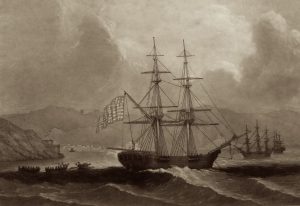 In 1799, in an area of the Caribbean Sea that had been listed as off limits for American ships, the English cutter, Sparrow intercepted the American brig, Nancy. The Nancy was in a place they should not have been, but the captain, Thomas Briggs produced papers claiming the ship was owned by a Dutchman. The captain of the Sparrow was skeptical, suspecting a smuggler. The problem was that he lacked evidence as to the true status of the Nancy, or the real reason for her trip. Due to his doubts about status and a lack of trust of the Nancy’s captain, the Sparrow’s captain sent Briggs to Jamaica to have his case heard by the vice-admiralty.
In 1799, in an area of the Caribbean Sea that had been listed as off limits for American ships, the English cutter, Sparrow intercepted the American brig, Nancy. The Nancy was in a place they should not have been, but the captain, Thomas Briggs produced papers claiming the ship was owned by a Dutchman. The captain of the Sparrow was skeptical, suspecting a smuggler. The problem was that he lacked evidence as to the true status of the Nancy, or the real reason for her trip. Due to his doubts about status and a lack of trust of the Nancy’s captain, the Sparrow’s captain sent Briggs to Jamaica to have his case heard by the vice-admiralty.
It turns out the captain of the Sparrow was not wrong in his doubts. Two days later, another English ship, the Ferret, caught a large shark near the coast of Haiti. When the cut the fish open, they found in its belly the papers of the American ship Nancy. Apparently, the Nancy’s captain, Thomas Briggs had thrown them overboard before getting false Dutch papers in Curacao. It was simply a fluke that the  Ferret somehow managed to catch the very shark that ate the real papers. I suppose that if the Nancy’s captain had used any common sense at all, he would have burned the papers, and then thrown the ashes overboard. The likelihood of having any useable paperwork after they were burned, would be extremely slim. The valid papers for the Nancy were dubbed the “shark papers.” They were produced in court, and the Nancy and her cargo were confiscated.
Ferret somehow managed to catch the very shark that ate the real papers. I suppose that if the Nancy’s captain had used any common sense at all, he would have burned the papers, and then thrown the ashes overboard. The likelihood of having any useable paperwork after they were burned, would be extremely slim. The valid papers for the Nancy were dubbed the “shark papers.” They were produced in court, and the Nancy and her cargo were confiscated.
The Nancy truly was an American sailing vessel, even though the captain tried to hide that fact. It was a type of ship noted in sources as either a brig or a brigantine, and it had been chartered to transport war supplies during the American Revolutionary War. When Michael Fitton, captain of the schooner Ferret, tender to HMS Abergavenny, cruised the Mona Passage in company with Sparrow, commanded by Mr Whylie, the two accidentally separated for a few days. On rejoining, Fitton invited Whylie by signal to come to breakfast, and 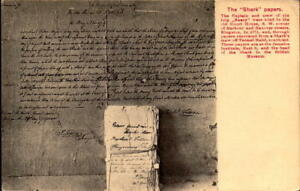 while waiting caught a large shark that was under the stern. In its stomach was a packet of papers relating to an American brig Nancy. When Whylie came on board, he mentioned that he had detained an American brig called Nancy. Fitton said that he had her papers. A shocked Whylie exclaimed, “Papers? Why, I sealed up her papers and sent them in with her.” “Just so, those were her false papers; here are her real ones,” replied Fitton. Proof positive. The fate of the Nancy and her captain were sealed. The shark’s jaws were set up on shore, with the inscription, “Lieutenant Fitton recommends these jaws for a collar for neutrals to swear through.” The papers are in the museum of the Royal United Service Institution.
while waiting caught a large shark that was under the stern. In its stomach was a packet of papers relating to an American brig Nancy. When Whylie came on board, he mentioned that he had detained an American brig called Nancy. Fitton said that he had her papers. A shocked Whylie exclaimed, “Papers? Why, I sealed up her papers and sent them in with her.” “Just so, those were her false papers; here are her real ones,” replied Fitton. Proof positive. The fate of the Nancy and her captain were sealed. The shark’s jaws were set up on shore, with the inscription, “Lieutenant Fitton recommends these jaws for a collar for neutrals to swear through.” The papers are in the museum of the Royal United Service Institution.
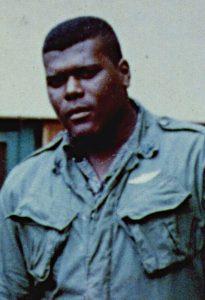 Combat diving…yes, that’s a real thing. Navy divers are used in ships maintenance, marine construction and salvage, demolition and mine clearance, and special forces. Army divers may be used in engineering activities such as bridge construction and demolition, and by special forces units. I guess that when I considered combat diving, I thought of underwater battles, and once in a while, that was the case. One case I heard of recently is that of Robert Hughes. Sergeant Hughes served as the Dive NCO for First Force Recon Company during 1967 to 1968. Born September 26, 1951, Hughes grew into a tall muscular man, and that helped him in the performance of his duties. During the Vietnam War, it seems that while divers had jobs to do routinely below the surface of the water, the Vietcong had a tendency to try to sabotage the divers, and that’s when they knew what real combat diving was.
Combat diving…yes, that’s a real thing. Navy divers are used in ships maintenance, marine construction and salvage, demolition and mine clearance, and special forces. Army divers may be used in engineering activities such as bridge construction and demolition, and by special forces units. I guess that when I considered combat diving, I thought of underwater battles, and once in a while, that was the case. One case I heard of recently is that of Robert Hughes. Sergeant Hughes served as the Dive NCO for First Force Recon Company during 1967 to 1968. Born September 26, 1951, Hughes grew into a tall muscular man, and that helped him in the performance of his duties. During the Vietnam War, it seems that while divers had jobs to do routinely below the surface of the water, the Vietcong had a tendency to try to sabotage the divers, and that’s when they knew what real combat diving was.
While hunting the Vietcong fighters, it was not uncommon for US troops to observe the Vietnamese flee underwater and never reemerge. It was proof that they had made their escape into one of the countless tunnel entrances located below the water. The US had scuba trained Force Recon Marines, who would comb the river bed looking for bodies, equipment caches, or  enemy tunnels. It was during one such mission that Hughes fought the battle that would earn him his reputation.
enemy tunnels. It was during one such mission that Hughes fought the battle that would earn him his reputation.
Hughes had always been called a “gentle giant” by the Marines he served with. Of course, it was his size that earned him the giant part…Hughes towered over many of his peers. He was a gentle man, but all that disappeared when he was engaged in a battle with the VC fighters. Then he became a virtual tiger. On one dive mission, Hughes was given the task of locating an underwater tunnel. He was searching through the murky darkness. As he felt his way along a bank with one hand, Kabar knife ready in the other. He located what appeared to be the tunnel entrance, and suddenly an enemy diver shot out of the hole. A fierce battle ensued. It was a fight for his life. Hughes knew that he had to kill or be killed. Submerged and hampered by limited visibility, Hughes fought to get control of  his enemy. Finally, he gained the upper hand. Hughes wrapped his legs around his enemy and pulled him in close. Then he spit out his regulator, lunged forward, and bit into the diver’s throat, ripping it out. The diver released his grip and Hughes finished the fight. This wasn’t the only “kill” to Hughes’ credit, but it was quite possible the most dramatic. Not many people have fought to the death by ripping out the throat of their enemy with their teeth. Hughes was a tiger in battle. One marine who served with him, said, “There was no one I would rather have as security underwater than Sergeant Hughes.” Hughes was an amazing soldier. Sergeant Robert “Gentle Giant” Hughes died on February 14, 1990.
his enemy. Finally, he gained the upper hand. Hughes wrapped his legs around his enemy and pulled him in close. Then he spit out his regulator, lunged forward, and bit into the diver’s throat, ripping it out. The diver released his grip and Hughes finished the fight. This wasn’t the only “kill” to Hughes’ credit, but it was quite possible the most dramatic. Not many people have fought to the death by ripping out the throat of their enemy with their teeth. Hughes was a tiger in battle. One marine who served with him, said, “There was no one I would rather have as security underwater than Sergeant Hughes.” Hughes was an amazing soldier. Sergeant Robert “Gentle Giant” Hughes died on February 14, 1990.
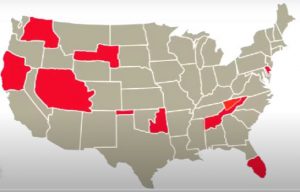
 When we think of how the 50 states of the United States were formed, we somehow think of an orderly process that followed a specific protocol, but in many ways, that was not the case. There are actually a number of states that were planned, or even in place for a time, but failed to continue to be or failed to form into states that exist today. These states were often formed out of conflict, when people didn’t like what they saw around them, and they decided to take matters into their own hand. Had they continued to exist, it would have felt normal, but in light of today’s United States, they would have been really strange. Even the names of these proposed states were rather strange.
When we think of how the 50 states of the United States were formed, we somehow think of an orderly process that followed a specific protocol, but in many ways, that was not the case. There are actually a number of states that were planned, or even in place for a time, but failed to continue to be or failed to form into states that exist today. These states were often formed out of conflict, when people didn’t like what they saw around them, and they decided to take matters into their own hand. Had they continued to exist, it would have felt normal, but in light of today’s United States, they would have been really strange. Even the names of these proposed states were rather strange.
Things like Westsylvania, Transylvania, Muskogee, and Deseret; make me wonder how they came up with this stuff. Of course many of us have heard of Transylvania, but it had nothing to do wit Dracula or any other vampire. Sorry if that disappoints some people. Transylvania’s name, meaning “across the woods” in Latin, stems from the university’s founding in the heavily forested region of western Virginia known as the 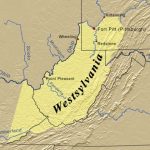
 Transylvania Colony, which became most of Kentucky in 1792. The state was founded in 1775, and statehood removed in 1776, when Virginia when the Virginia General Assembly invalidated the Transylvania Purchase.
Transylvania Colony, which became most of Kentucky in 1792. The state was founded in 1775, and statehood removed in 1776, when Virginia when the Virginia General Assembly invalidated the Transylvania Purchase.
The proposed state of Westsylvania was located in what is now West Virginia, southwestern Pennsylvania, and small parts of Kentucky, Maryland, and Virginia. Westsylvania was proposed early in the American Revolution It would have been the fourteenth state in the newly formed United States, had it been recognized. In the final years of the Revolutionary War…in 1782, Hugh Henry Brackenridge, a Pittsburgh lawyer and strong supporter of the national government, convinced the Pennsylvania Assembly to declare that agitation for a separate state was treason, rendering the promotion of Westsylvania subject to the death penalty. Pennsylvania also sent secret agents, such as the Reverend James Finley, to work against the Westsylvania movement. According to historian Jack Sosin, “Finely’s efforts, the threat that the settlers’ land might be sold, and the cool reaction to the proposed new state by Congress finally quieted the Westerners.”

 In all, there were about 12 proposed states that if ratified, would have changed the United States as we know it. I can’t imagine having 62 states, or living in a state called Absaroka, Delmarva, Scott, Nickajack, or Sequoyah. And while I was born in Superior, Wisconsin, I can’t imagine living in the state of Superior. And of course, Transylvania, Westsylvania, Lincoln, Muskogee, Deseret, or Franklin would be equally odd. While these “states” did exist for a time, I rather like our country just the way it is. Fifty states is a nice round number.
In all, there were about 12 proposed states that if ratified, would have changed the United States as we know it. I can’t imagine having 62 states, or living in a state called Absaroka, Delmarva, Scott, Nickajack, or Sequoyah. And while I was born in Superior, Wisconsin, I can’t imagine living in the state of Superior. And of course, Transylvania, Westsylvania, Lincoln, Muskogee, Deseret, or Franklin would be equally odd. While these “states” did exist for a time, I rather like our country just the way it is. Fifty states is a nice round number.
 The London Zoo housed a male golden eagle in the 1960s that they named Goldie. As we know, eagles love to fly high and be free. I don’t think they take well to being fenced in, at least Goldie certainly didn’t take well to it. On February 28, 1965, Goldie decided to take back his freedom. Goldie’s escape caused a nationwide sensation for the 12 days of his freedom. Then they caught him again. I feel sad for Goldie after he was caught, because being free was all he really wanted.
The London Zoo housed a male golden eagle in the 1960s that they named Goldie. As we know, eagles love to fly high and be free. I don’t think they take well to being fenced in, at least Goldie certainly didn’t take well to it. On February 28, 1965, Goldie decided to take back his freedom. Goldie’s escape caused a nationwide sensation for the 12 days of his freedom. Then they caught him again. I feel sad for Goldie after he was caught, because being free was all he really wanted.
Goldie first flew away from his keepers, while his cage was being cleaned. He saw his chance and he took it. Enjoying his newfound freedom, Goldie avoided being recaptured for nearly two weeks, despite a massive effort using equipment borrowed from the Royal Navy and Civil Defense Corps. He didn’t seem to have a desire to stray too far, and spent most of the time in Regent’s Park, which is the area surrounding the zoo. He also made a few  excursions into the nearby neighborhoods of Camden Town, Tottenham Court Road, and Euston. Those excursions brought him into the British public eye, and people were excited about this bit of celebrity. The zoo began receiving phone calls and letters in the thousands. Regent’s Park was the site of large crowds gathered to watch the bird’s keepers trying to catch Goldie. Drivers circled the park to watch Goldie in flight, causing severe traffic jams in the area. Of course, the media had a field day with the whole thing. There is nothing more interesting that watching the spectacle of a bunch of trainers trying to chase down an eagle…like they would have an easy success there. In fact the opposite was true, because Goldie spent two weeks roaming free before they finally caught him. Goldie was pretty resourceful too, because he managed to kill a duck in the garden of Winfield House, official residence of the United States Ambassador to the United Kingdom, within Regent’s Park. Goldie also attacked two terriers in the park, but was driven off by their owner. Of course, nobody likes to think about that part, but it is normal for a predatory bird. In fact, it was food that finally
excursions into the nearby neighborhoods of Camden Town, Tottenham Court Road, and Euston. Those excursions brought him into the British public eye, and people were excited about this bit of celebrity. The zoo began receiving phone calls and letters in the thousands. Regent’s Park was the site of large crowds gathered to watch the bird’s keepers trying to catch Goldie. Drivers circled the park to watch Goldie in flight, causing severe traffic jams in the area. Of course, the media had a field day with the whole thing. There is nothing more interesting that watching the spectacle of a bunch of trainers trying to chase down an eagle…like they would have an easy success there. In fact the opposite was true, because Goldie spent two weeks roaming free before they finally caught him. Goldie was pretty resourceful too, because he managed to kill a duck in the garden of Winfield House, official residence of the United States Ambassador to the United Kingdom, within Regent’s Park. Goldie also attacked two terriers in the park, but was driven off by their owner. Of course, nobody likes to think about that part, but it is normal for a predatory bird. In fact, it was food that finally  caught Goldie. He was finally caught on 11 March after the zoo’s deputy head keeper tempted him to earth with a dead rabbit. He was in good health after his experience and was reunited with his mate, Regina, which may have been the reason Goldie stayed in the area. The zoo’s attendance nearly doubled in the days after his return. That wasn’t the end of Goldie’s story however. Goldie escaped once again on December 15, 1965, and was recaptured December 19, 1965. I think that while Goldie loved his mate, Regina, he didn’t want to be fenced in. Golden eagles are monogamous, staying with their mate for years or even life. On March 8, 1985, Goldie was sent to the Falconry Centre in Newent, and died there about March 23, 1986.
caught Goldie. He was finally caught on 11 March after the zoo’s deputy head keeper tempted him to earth with a dead rabbit. He was in good health after his experience and was reunited with his mate, Regina, which may have been the reason Goldie stayed in the area. The zoo’s attendance nearly doubled in the days after his return. That wasn’t the end of Goldie’s story however. Goldie escaped once again on December 15, 1965, and was recaptured December 19, 1965. I think that while Goldie loved his mate, Regina, he didn’t want to be fenced in. Golden eagles are monogamous, staying with their mate for years or even life. On March 8, 1985, Goldie was sent to the Falconry Centre in Newent, and died there about March 23, 1986.
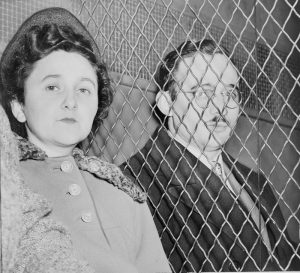
 I could never begin to understand how an American citizen could be so evil as to commit espionage against the United States by selling secrets to other countries, but then again, that is not something that is so unusual these days. In the 1940’s, however, it wasn’t so common. Nevertheless, Julius Rosenberg and Ethel Rosenberg were American citizens who were convicted of spying on behalf of the Soviet Union. The Rosenbergs were accused of providing top-secret information about radar, sonar, jet propulsion engines, and valuable nuclear weapon designs to the Soviet Union at a time when the United States was the only country in the world with nuclear weapons. Imagine if we could go back to that time. The Rosenbergs were convicted of espionage in 1951, and they were executed by the federal government of the United States in 1953 in the Sing Sing correctional facility in Ossining, New York. They were the first American civilians to be executed for such charges and the first to suffer that penalty during peacetime.
I could never begin to understand how an American citizen could be so evil as to commit espionage against the United States by selling secrets to other countries, but then again, that is not something that is so unusual these days. In the 1940’s, however, it wasn’t so common. Nevertheless, Julius Rosenberg and Ethel Rosenberg were American citizens who were convicted of spying on behalf of the Soviet Union. The Rosenbergs were accused of providing top-secret information about radar, sonar, jet propulsion engines, and valuable nuclear weapon designs to the Soviet Union at a time when the United States was the only country in the world with nuclear weapons. Imagine if we could go back to that time. The Rosenbergs were convicted of espionage in 1951, and they were executed by the federal government of the United States in 1953 in the Sing Sing correctional facility in Ossining, New York. They were the first American civilians to be executed for such charges and the first to suffer that penalty during peacetime.
On March 6, 1951, the trial of Ethel and Julius Rosenberg began in New York Southern District federal court. Presiding over the espionage trial was Judge Irving R Kaufman. The couple was charged with espionage, rather than treason, because the latter could not be charged since the United States was not at war with the Soviet Union at the time of the crime’s commission. The father and son team of Emanuel and Alexander Bloch defended the Rosenbergs and their co-defendant, Morton Sobell. Roy Cohn, best known for his association with Senator Joseph McCarthy prosecuted the trio.
The Rosenbergs and Sobell, along with other co-conspirators were directly responsible for the beginning of the Cold War. Julius Rosenberg’s brother-in-law, David Greenglass was a machinist at Los Alamos, where America developed the atomic bomb. Rosenberg was a member of the American Communist Party and was fired from his government job during the Red Scare. According to Greenglass, Rosenberg asked him to pass highly confidential instructions on making atomic weapons to the Soviet Union. In compliance, Greenglass gave the information to Harry Gold, who gave it to the Russians. The Soviets exploded their first atomic bomb in September 1949, effectively starting the Cold War, based on information, including that from Greenglass, they had obtained from spies.
The confession of Greenglass was the only direct evidence of the Rosenberg’s involvement. The left-wing  community believed that the Rosenbergs were prosecuted because of their membership in the Communist Party. The Rosenbergs became the cause of leftists throughout the nation. The rest of their family, including their two sons declared the innocence of the Rosenbergs for years. The trial lasted nearly a month…ending on April 4, 1951. Sobell received a thirty year sentence. Greenglass got fifteen years for his cooperation. Reportedly, the Rosenbergs were offered a deal in which their death sentences would be commuted in return for an admission of their guilt. They refused and were executed. In 2008, the only surviving defendant, Morton Sobell, admitted that he was a Soviet spy and implicated Julius Rosenberg in industrial and military espionage.
community believed that the Rosenbergs were prosecuted because of their membership in the Communist Party. The Rosenbergs became the cause of leftists throughout the nation. The rest of their family, including their two sons declared the innocence of the Rosenbergs for years. The trial lasted nearly a month…ending on April 4, 1951. Sobell received a thirty year sentence. Greenglass got fifteen years for his cooperation. Reportedly, the Rosenbergs were offered a deal in which their death sentences would be commuted in return for an admission of their guilt. They refused and were executed. In 2008, the only surviving defendant, Morton Sobell, admitted that he was a Soviet spy and implicated Julius Rosenberg in industrial and military espionage.

 Anyone who has been around very long knows what a fire hydrant is. Before the fire hydrant, water ad to be transported to a fire. If there was a water source nearby, they would often use a bucket brigade, but if not they had to try to bring it in by wagon. Bucket brigades weren’t very efficient, but they were all they had at the time. Firefighters stood in a line between the fire and the source of water and passed buckets along, one by one until the fire was extinguished. All too often, even in the cities, the structure burned to the ground because the source of water was simply too far away to save it. Finally, when city water became a thing, someone came up with the idea of a fire hydrant. This invention has worked so well, that it has saved untold numbers of lives and structures. These days there is a fire hydrant on just about every block. In fact, they are so common that we really don’t notice them at all.
Anyone who has been around very long knows what a fire hydrant is. Before the fire hydrant, water ad to be transported to a fire. If there was a water source nearby, they would often use a bucket brigade, but if not they had to try to bring it in by wagon. Bucket brigades weren’t very efficient, but they were all they had at the time. Firefighters stood in a line between the fire and the source of water and passed buckets along, one by one until the fire was extinguished. All too often, even in the cities, the structure burned to the ground because the source of water was simply too far away to save it. Finally, when city water became a thing, someone came up with the idea of a fire hydrant. This invention has worked so well, that it has saved untold numbers of lives and structures. These days there is a fire hydrant on just about every block. In fact, they are so common that we really don’t notice them at all.
Credit for the invention of the fire hydrant often goes to Frederick Graff Sr, who invented the first pillar fire hydrant in 1801, however fire hydrants were in place before that. The main reason that the credit has gone to Graff is that the name of the real inventor has been lost. We know that it was invented in Philadelphia, Pennsylvania in the early 1800s. That said, it must have been right before Graff’s version, which is said to have been invented in 1801. The patent with the name of the true inventor was destroyed, but just how that happened is unknown. There are stories of fire, floods, and even an argument that caused the destruction of them. Whatever happened, we will never really know the truth on this. However, we do know for a fact that Graff created the first pillar fire hydrant in 1801, which is the reason why he receives credit for it today.

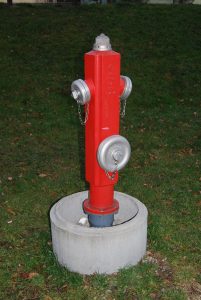
We owe a debt of gratitude to the inventor of the fire hydrant, whoever he may be, but we have no idea who to credit for it. I find it very strange that even the story of how the patent was lost is a mystery. It almost seems like it has been hidden for a specific purpose. It makes me wonder if the two men fought over who was the real inventor. Maybe they even worked on it together. Since both are now gone, we can’t even ask. The whole matter feels unreal, but we are left with the mystery anyway. Over the years styles and designs of hydrants have varied by country, state, and city, but the basic design is still the same. It pulls water from the underground source and connects it to the firefighters hose so water can be sprayed on the fire to put out the fire.

 As the world first began to be settled, the Hawaiian Islands were discovered, and in approximately 400AD Polynesians from the Marquesas Islands traveled the 2000 miles distance to Hawaii’s Big Island in canoes. To get to Hawaii, they navigated by the sun and stars, reading the winds, currents, and seabirds’ flight. The Polynesians sailed across the open ocean in great double-hulled canoes. The Polynesians brought with them items essential to their survival, including pigs, dogs, and chickens; the roots of kalo (a root vegetable and one of the most complex carbohydrates on the planet) and sweet potato; the seeds and saplings of coconut, banana, sugar cane, and other edible and medicinal plants. Polynesians were well-established on the islands when Polynesians from the Society Islands arrived in Hawaii. These newcomers became the new rulers of Hawaii. After a time of voyaging back and forth between the Society Islands and the Hawaiian Archipelago, contact with southern Polynesia ceased. During the 400 years of isolation that followed, a unique Hawaiian culture developed. That is similar to what happened when the pilgrims came to the new world…present-day United States. Once away from the culture one comes from, new ideas and new skills begin to form.
As the world first began to be settled, the Hawaiian Islands were discovered, and in approximately 400AD Polynesians from the Marquesas Islands traveled the 2000 miles distance to Hawaii’s Big Island in canoes. To get to Hawaii, they navigated by the sun and stars, reading the winds, currents, and seabirds’ flight. The Polynesians sailed across the open ocean in great double-hulled canoes. The Polynesians brought with them items essential to their survival, including pigs, dogs, and chickens; the roots of kalo (a root vegetable and one of the most complex carbohydrates on the planet) and sweet potato; the seeds and saplings of coconut, banana, sugar cane, and other edible and medicinal plants. Polynesians were well-established on the islands when Polynesians from the Society Islands arrived in Hawaii. These newcomers became the new rulers of Hawaii. After a time of voyaging back and forth between the Society Islands and the Hawaiian Archipelago, contact with southern Polynesia ceased. During the 400 years of isolation that followed, a unique Hawaiian culture developed. That is similar to what happened when the pilgrims came to the new world…present-day United States. Once away from the culture one comes from, new ideas and new skills begin to form.
The Hawaiian people were highly skilled farmers and fishermen, who lived in small communities ruled by chieftains who battled one another for territory. The new Hawaiian culture was a highly stratified society with strictly maintained classes of people. The chiefs headed the social pyramid and ruled over the land. The highest class, the Kahuna (professionals) were highly regarded and sometimes feared, they were experts on religious ritual or specialists in canoe-building, herbal medicine, and healing. The middle class, the maka`ainana (commoners) farmed, fished, built walls, houses, and fishponds…and paid taxes to the paramount chiefs and his chiefs. Kauwa, the lowest class, were outcasts or slaves. I can’t say that the class society was fair, because it really wasn’t, but many societies of that era were ruled in that way, and in reality, this class society still exists…maybe with slight differences, but it still exists.
In many ways, the culture was quite oppressive, especially to women. A system of laws known as Kanawai enforced Hawaii’s social order. Certain people, places, things, and times were considered sacred. Being near them was kapu, or forbidden except to a very privileged few. Women ate apart from men and were restricted from eating pork, coconuts, bananas, or a variety of other foods. Kapu regulated fishing, planting, and the harvesting of other resources, thus ensuring their conservation. Any breaking of kapu disturbed the stability of society, and the punishment for breaking this law was usually death.
Still, even with the strict laws, village life was rich and interesting. Hawaiians fished in coastal waters and collected shellfish, seaweed, and salt along the shore. They raised pigs, dogs, and chickens and harvested sweet potatoes, kalo, and other crops. Men pounded kalo into poi, which is the staple food of Hawaiians, while women beat the inner bark of wauke (paper mulberry) into kapa (bark cloth). The sounds of taro pounding and 
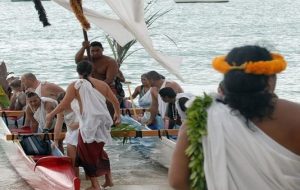 kapa beating were rhythmical signatures of Hawaiian village life. That changed dramatically after Captain James Cook arrived in 1778 and introduced the rest of the world to Hawaii. Cook, who named the islands after the Earl of Sandwich, returned a year later and was killed in a confrontation with Hawaiians at Kealakekua Bay, on Hawaii’s Big Island. Still his impact on the state of Hawaii remains.
kapa beating were rhythmical signatures of Hawaiian village life. That changed dramatically after Captain James Cook arrived in 1778 and introduced the rest of the world to Hawaii. Cook, who named the islands after the Earl of Sandwich, returned a year later and was killed in a confrontation with Hawaiians at Kealakekua Bay, on Hawaii’s Big Island. Still his impact on the state of Hawaii remains.

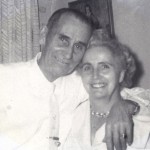 My grandma, Hattie Byer was the only grandmother I had while growing up, because my dad’s parents passed before and shortly after I was born. Grandma was a multi-faceted person, probably by necessity. She and my grandpa, George Byer had nine children…seven girls and two boys. As a stay-at-home mom, grandma was the main disciplinarian in the family. Grandpa worked long hours, and while he could discipline the kids, he truly had a soft heart, and I think it pained him when he had to impose discipline on his kids. I think that happens a lot. In my family, I was the disciplinarian too. My mom, Collene Spencer has told me of some of the times she got on the wrong side of her mother, with negative consequences. Lets just say that when your brother is getting in trouble, you best stay out of it, because sassing your mom is never a good idea.
My grandma, Hattie Byer was the only grandmother I had while growing up, because my dad’s parents passed before and shortly after I was born. Grandma was a multi-faceted person, probably by necessity. She and my grandpa, George Byer had nine children…seven girls and two boys. As a stay-at-home mom, grandma was the main disciplinarian in the family. Grandpa worked long hours, and while he could discipline the kids, he truly had a soft heart, and I think it pained him when he had to impose discipline on his kids. I think that happens a lot. In my family, I was the disciplinarian too. My mom, Collene Spencer has told me of some of the times she got on the wrong side of her mother, with negative consequences. Lets just say that when your brother is getting in trouble, you best stay out of it, because sassing your mom is never a good idea.
Grandma was also the family chef. She made the best of so many dishes. Her Potato Pancakes have never been beaten,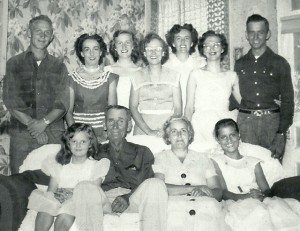 and yes, I’m biased, but so is every other person who has ever had them. Her Potato Milk Soup was heavenly, and her Oyster Stew was loved by many. Of course, it was my grandmother’s good cooking that created all the good cooks in the family. She taught her girls, and her boys too, to cook and they were and are still very good cooks. They don’t make exotic dishes, they make good old fashioned “Comfort Food,” and nobody makes it better than they do. Grandma could make a great mean out of almost nothing, and during the Great Depression, that is just what she did, as many a hungry guest can attest. Grandma always had extras at the table in those years. People instinctively knew where they could go to be welcomed to dine at a moment’s notice. None were turned away, and all ate to their fill.
and yes, I’m biased, but so is every other person who has ever had them. Her Potato Milk Soup was heavenly, and her Oyster Stew was loved by many. Of course, it was my grandmother’s good cooking that created all the good cooks in the family. She taught her girls, and her boys too, to cook and they were and are still very good cooks. They don’t make exotic dishes, they make good old fashioned “Comfort Food,” and nobody makes it better than they do. Grandma could make a great mean out of almost nothing, and during the Great Depression, that is just what she did, as many a hungry guest can attest. Grandma always had extras at the table in those years. People instinctively knew where they could go to be welcomed to dine at a moment’s notice. None were turned away, and all ate to their fill.
My grandmother was a woman of small stature, just 5′ in her tall days. I’m not sure where her height came from, because her sisters were certainly much taller than the was. Since I have no idea how tall her mother, or grandmothers were, I guess it might be quite normal for her to be short. Still I have often wondered how she 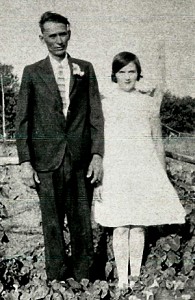
 ended up so short. By the time I really gave much thought to her height, she had shrunk some, and probably stood 4’10” tall…or short, as it were. She didn’t need to be real tall to catch Grandpa’s eye, however. He was in love almost immediately. Grandpa stood over 6′ tall, so there was quite a contrast there, but they always made a sweet couple, and Grandpa was always proud of his beautiful wife. Grandma was a multi-faceted person, who could handle many things, and we have all always been very proud of her too. Today would have been Grandma Byer’s 112th birthday. Happy birthday in Heaven Grandma. I know you and Grandpa are having a wonderful celebration. We love and miss you very much.
ended up so short. By the time I really gave much thought to her height, she had shrunk some, and probably stood 4’10” tall…or short, as it were. She didn’t need to be real tall to catch Grandpa’s eye, however. He was in love almost immediately. Grandpa stood over 6′ tall, so there was quite a contrast there, but they always made a sweet couple, and Grandpa was always proud of his beautiful wife. Grandma was a multi-faceted person, who could handle many things, and we have all always been very proud of her too. Today would have been Grandma Byer’s 112th birthday. Happy birthday in Heaven Grandma. I know you and Grandpa are having a wonderful celebration. We love and miss you very much.

